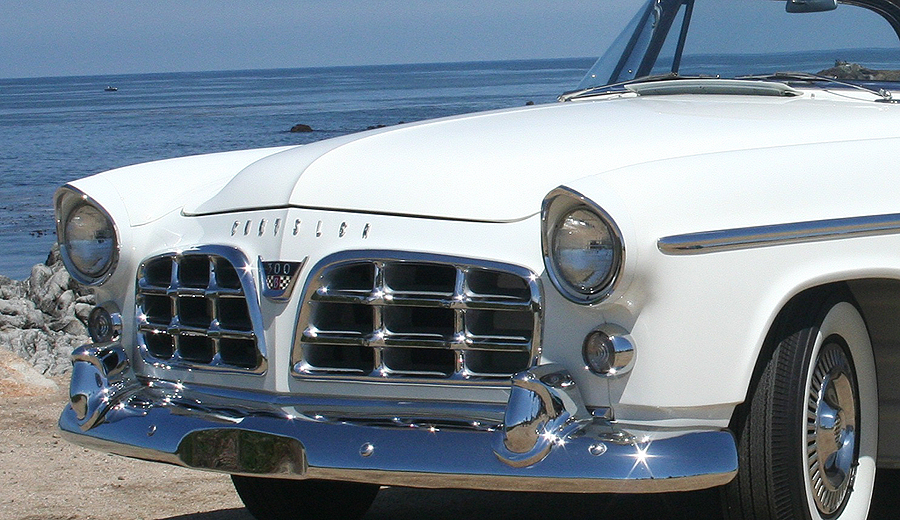|
The success of the original 1955 C-300 inspired
Chrysler Division to try again, so an improved version, the C-300B,
was scheduled for the 1956 model year. Contrary to many accounts, the
C-300B was not an Imperial derivative. The basic body was the same as
the C-71 Windsor, with different holes drilled in the body in white
(before paint) stage. The only Imperial parts were the front panel
that held the grilles, and the grilles themselves. 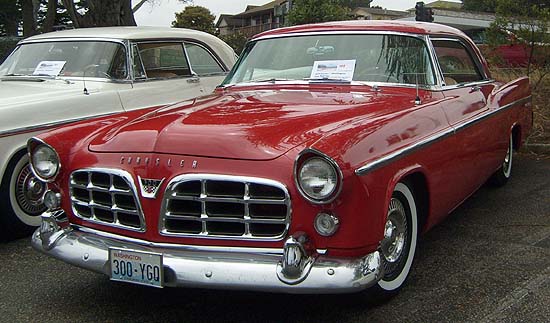 The hood was
common with all series, but was listed as Imperial since it was not
drilled for the eagle ornament used on the Windsor and New Yorker
series. Wheel covers were Imperial with a 300 plastic emblem
substituted for the Imperial emblem. The running gear was basically
New Yorker. As far as can be determined, only the race cars ever
received the larger spindles, bearings, rear axles, etc which were
standard on Imperials and Chrysler wagons. The hood was
common with all series, but was listed as Imperial since it was not
drilled for the eagle ornament used on the Windsor and New Yorker
series. Wheel covers were Imperial with a 300 plastic emblem
substituted for the Imperial emblem. The running gear was basically
New Yorker. As far as can be determined, only the race cars ever
received the larger spindles, bearings, rear axles, etc which were
standard on Imperials and Chrysler wagons.
The C-300B interior was the same
design as the C-71 Windsor except the seats were built over the C-72
New Yorker patterns. Of course, special colors were used on the dash,
steering wheel, door and quarter interior trim panels, etc. To save
money, a few of the genuine leather seat panels used in 1955 were
replaced with vinyl in 1956, but basically the interior was unchanged
from 1955.
Engine changes included a switch to
hardened crankshafts, malleable iron main bearing caps and tri-metal
bearings, all standard truck items. 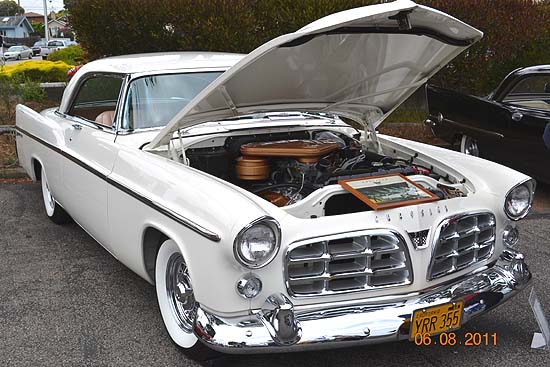 These were running changes during
1955 and no serial number records exist. Displacement was increased
to 354 cubic inches, the production camshaft was altered slightly
(1955 part number 1635736; 1956 part number 1637518), and the
compression ratio was increased from 8.5:1 to 9.0:1 resulting in 340
HP. With optional 10.0:1 heads, 355 HP was available, the only 300
engine to ever achieve more than one horsepower per cubic inch. These were running changes during
1955 and no serial number records exist. Displacement was increased
to 354 cubic inches, the production camshaft was altered slightly
(1955 part number 1635736; 1956 part number 1637518), and the
compression ratio was increased from 8.5:1 to 9.0:1 resulting in 340
HP. With optional 10.0:1 heads, 355 HP was available, the only 300
engine to ever achieve more than one horsepower per cubic inch.
Sales for all models were slow in
1956 and a great push was put on to close out accessory stocks in the
spring. Many cars were equipped with wire wheels and record players,
as these parts would not fit the 1957’s. Some late Imperials
and 300’s were also equipped with the new Torqueflite
transmission, improving acceleration over that of Powerflite equipped
cars.
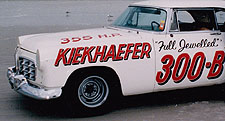
Rear axle ratios up to 3.91 were in
the standard carrier assembly, from 4.10 to 4.89 then used the
Imperial assembly, and from 5.38 to 6.17 used a truck carrier
assembly. Of course these higher ratios were listed strictly for
racing, as Kiekhaefer needed them.
The production tires were most
unusual. Called Goodyear Blue Streak, they had a low cord angle to
reduce tire growth and deflection at high speed. The low cord angle
also reduced “morning sickness”, the flat spotting that
caused a lumpy ride, standard in the 4-ply Nylon tires of the
mid-50’s when they stood overnight. Goodyear used an obsolete
tread pattern for these tires, and probably used modified molds, as
the tire had a “wide oval” cross section when compared to
standard tires, much like the difference between the 78 series and
the 70 series tires today.
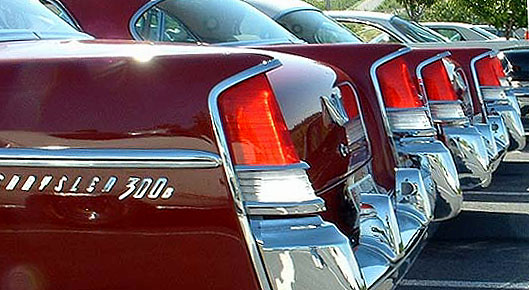 Basic changes common to all the 1956
cars made the C-300B a better car to drive than the 1955 C-300. The
1955 cars were marginal on starting torque for hot starts; the 1956
12 volt ignition system eliminated this problem. The 1955 cars used
the same reliable 12 inch Lockheed style brakes as previously, but
switched to a small cowl-mounted power unit in place of the massive
under-seat unit used in prior years. This inadequate booster assembly
simply did not have enough power to lock up the non-servo action
Lockheed style brake. In 1956 a Chrysler designed servo type brake
was installed, along with a larger cowl mounted power unit. This
combination permitted a low pedal position with plenty of power to
lock the wheels. Unfortunately, these brakes tended to squeal unless
everything was perfect, causing a lot of customer complaints. Basic changes common to all the 1956
cars made the C-300B a better car to drive than the 1955 C-300. The
1955 cars were marginal on starting torque for hot starts; the 1956
12 volt ignition system eliminated this problem. The 1955 cars used
the same reliable 12 inch Lockheed style brakes as previously, but
switched to a small cowl-mounted power unit in place of the massive
under-seat unit used in prior years. This inadequate booster assembly
simply did not have enough power to lock up the non-servo action
Lockheed style brake. In 1956 a Chrysler designed servo type brake
was installed, along with a larger cowl mounted power unit. This
combination permitted a low pedal position with plenty of power to
lock the wheels. Unfortunately, these brakes tended to squeal unless
everything was perfect, causing a lot of customer complaints.
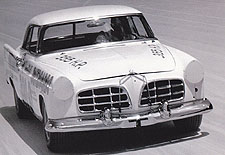 The 300B was the fastest stock car in
1956, turning 139.373 MPH on the sand at Daytona. This record stood
among 300’s until 1960. The acceleration of the 300B was also
exceptional, with Hot Rod magazine reporting a 0-60 time of 9.0
seconds, 0-80 in 15.1 seconds and ¼ mile in 17.0 seconds, 84.1
MPH for “America’s Hottest Stock Car”. Their test
car had 3.54 gear and Powerflite. Very excellent fuel economy was
also noted, especially for such a large car (test weight 4440 lbs.).
Normal city driving averaged 16.8 MPG and the overall average was
13.3 MPG, including the strip testing.
The 300B was the fastest stock car in
1956, turning 139.373 MPH on the sand at Daytona. This record stood
among 300’s until 1960. The acceleration of the 300B was also
exceptional, with Hot Rod magazine reporting a 0-60 time of 9.0
seconds, 0-80 in 15.1 seconds and ¼ mile in 17.0 seconds, 84.1
MPH for “America’s Hottest Stock Car”. Their test
car had 3.54 gear and Powerflite. Very excellent fuel economy was
also noted, especially for such a large car (test weight 4440 lbs.).
Normal city driving averaged 16.8 MPG and the overall average was
13.3 MPG, including the strip testing.
The 300B was certainly one of the best 300’s.
Many 300 enthusiasts believe it was the pinnacle of the big, brutish,
powerful cars and all following 300’s were somewhat more
compromising. This we cannot say, but it was four years before the
300B was eclipsed as the fastest 300, an no succeeding 300 ever
matched its racing record.
(*) Ted Beebe has offered his
services to the club as a consultant on 1955 and 1956 300 problems
and questions. Ted was closely associated with the Chrysler 300
program during those years.
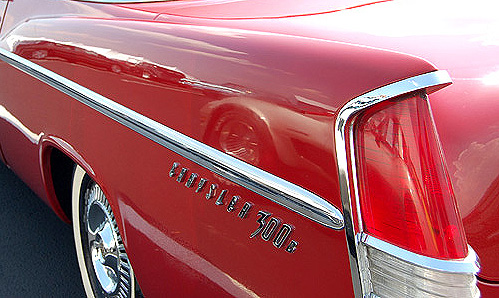
|
